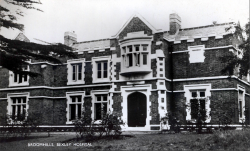Difference between revisions of "Bexley Hospital"
(Created page with "{{infobox institution | name = Bexley Hospital | image = bexley6.png | image_size = 250px | alt = | caption = | established = 1894 | construction_began = | construction_ended =...") |
m |
||
| Line 55: | Line 55: | ||
</gallery> | </gallery> | ||
| − | [[Category: | + | [[Category:London]] |
[[Category:Echelon Plan]] | [[Category:Echelon Plan]] | ||
[[Category:Demolished Institution]] | [[Category:Demolished Institution]] | ||
Latest revision as of 22:27, 8 April 2013
| Bexley Hospital | |
|---|---|
 | |
| Established | 1894 |
| Opened | 1897 |
| Closed | 1998 |
| Demolished | 2000 |
| Current Status | Demolished |
| Building Style | Echelon Plan (Compact Arrow) |
| Architect(s) | G.T. Hines |
| Location | Bexley, Kent |
| Alternate Names |
|
History[edit]
The seventh London County Asylum opened in 1898 on a 750 acre site adjacent to Dartford Heath, bought by the LCC four years previously. Known as the Heath Asylum, it cost £34,000 and would eventually accommodate over 2000 patients. However, only four male and three female ward blocks had been completed when the first patients were admitted; all had been committed, that is, they were not voluntary patients. A chapel which could seat 850 was commissioned soon after the Asylum opened.
By 1905 the Asylum was almost full; ten years later it held more than 2500 patients. Designed to be self-sufficient, the grounds contained a farm with livestock - cattle, pigs, chickens and ducks - and a large market garden which supplied fresh vegetables, all tended by the patients. In fact, the patients were also involved in the maintenance and upkeep of the Asylum - doing laundry, making beds, cleaning the wards and corridors - but received little in the way of treatment for their mental illness. Manual labour was regarded as an important occupation, as were recreational activities - indoor games (billiards, cribbage and darts - which surprisingly led to no casualties), art classes, pottery, workshops, drill classes, team games and other sports. Weekly dances were held in the huge recreation hall, which was also used for theatrical productions and concerts, communal singing and, later, cinema shows. Psychotherapy and medications for mental diseases were in their infancy and only began to be introduced after WW1.
In 1918 the Asylum was renamed Bexley Mental Hospital. By 1939 the main Hospital had 18 wards and a further three villas had been built. The operating theatre closed at the beginning of WW2. In 1944 a bomb destroyed a ward block, killing a male nurse and 12 patients.
The Hospital joined the NHS in 1948 and the war damage was repaired, the wards repainted in pastel colours and the furniture modernized. There was no X-ray department, but a mobile unit visited every week. An emergency call bell system was installed. Fluorescent lighting replaced the old system in the kitchen, nurses' sitting room and dental room. A Garden Party was held for the staff to celebrate the 50th Anniversary of the Hospital; the patients had theirs one week later. At this time there were 2141 patients (954 males and 1196 females), with 162 male nurses and 213 female nurses (82 of whom were part-time) caring for them. The night shift was covered by 16 male and 20 female nurses (a ratio of about 60:1).
Psychotherapy, leucotomy, ECT and insulin coma were the treatments available for nervous and emotional illnesses (as opposed to the psychoses). An injection of curare before ECT for patients with chronic depressive states enabled those with contraindications (TB, extreme debility, severe heart disease or fractures) to receive treatment.
After WW2 the proportion of patients aged over 65 had increased and represented one-third of the Hospital's population; a quarter of admissions were elderly patients with dementia. Several factors had played a part in this development: life expectancy had increased; women now went out to work, which meant that they could no longer take care of demented parents; and the number of beds for the chronic aged sick had decreased by half the pre-war amount because they had been destroyed during the war, or were being used for other purposes, or had closed due to lack of staff. This had resulted in the congestion of old people in psychiatric hospitals who did not need skilled psychiatric nursing or treatment.
In 1949 a hairdressing department opened on the female side of the Hospital. At this time there were 2195 beds, but a shortage of staff.
In the 1970s the Hospital had six wards for acute admissions and 32 wards for medium- and long-stay patients. In 1974 it had 1633 beds, but a gradual decline in bed occupancy began at this time and, in 1977, less than 1000 patients remained.
By 1985 goverment policy was dictating that mentally ill patients should be treated in the community and not in huge Victorian asylums. Acute psychiatric wards were established in district general hospitals while day hospitals, such as Castlewood, provided out-patient care for those with mental health problems. Community mental health units and community psychiatric nursing teams began to take over the work of the mental hospitals.
As with the other mental hospitals in the process of becoming redundant, Bexley Hospital with its 1000 beds became more difficult and expensive to maintain. In the 1990s the buildings on the west side of the campus were demolished.







